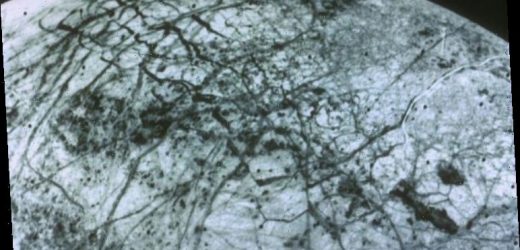Space: Dr. Michael Masters discusses time travel and aliens
When you subscribe we will use the information you provide to send you these newsletters.Sometimes they’ll include recommendations for other related newsletters or services we offer.Our Privacy Notice explains more about how we use your data, and your rights.You can unsubscribe at any time.
Whether life exists away from Earth remains one of the biggest mysteries to scientists. However, experts believe alien lifeforms could exist elsewhere in the solar system.
Scientists are pointing out Jupiter’s moons, particularly Europa, as a possible home to life, and several missions planned to the icy moon could confirm their suspicions.
Beneath the icy exterior of Europa lies a planet-wide body of water despite the freezing temperatures because of a process known as tidal heating.
Tidal heating is where the gravitational pull of the moons’ planet, in this case Jupiter, stretches the lunar satellites’ interior, causing it to heat enough to keep water in that state.
Professor Joachim Saur, a planetary scientist from the University of Cologne, Germany, said: “Europa is one of the best candidates for habitability because the liquid water is in direct contact with the silicate mantle.
“So there’s a possibility of the leaching out of minerals from the crust into the ocean. And the richer it is in chemical compounds, the better it is for the evolution of life.”
Prof Saur is the project coordinator of the Exo-Oceans project.
The research group looks for bodies of water on other celestial bodies, as water is an indicator of life – or so the theory goes on Earth at least.
Exo-Oceans is helping to launch the European Space Agency’s (ESA) Jupiter Icy Moons Explorer (JUICE) mission, which is scheduled to lift off next year and will arrive at Europa by 2029.
However, JUICE will also explore some of Jupiter’s other moons, such as Callisto and Ganymeade.
But Europa will be the best bet for finding life, according to the researchers.
Dr Lorenz Roth, a planetary astronomer and physicist from the KTH Royal Institute of Technology in Stockholm, Sweden, was part of the AuroraMHD project which looked at radiation levels on the moons.
Europa emits a constant aurora, as it is constantly being bombarded by radiation from Jupiter, which can be seen in ultraviolet images from Hubble.
DON’T MISS
‘Galileo wasn’t right’ Scientist untraveled mystery behind Church fury
NASA to launch alien hunting Europa Clipper on private rocket in 2024
NASA satellite captures solar flare on video with Jupiter lingering
AuroraMHD also helped to confirm water plumes coming from the surface of Europa, and how these bursts interacted with the atmosphere.
JUICE will help to build upon the study, according to Dr Roth.
He said: “The question of habitability and life always lingers in the background.
“In all aspects, including size, the large Jupiter moons are like planets: they are similar to or bigger than Mercury, one has a magnetic field, they have atmospheres, they have oceans (and so on).”
“Europa is more promising (because its) water is very likely directly connected to the rocky material at the sea floor, which allows some reaction to take place.
“Once JUICE is in orbit, we’ll get a lot of information.
“It can continuously measure the magnetic fields around the moons.”
Source: Read Full Article







